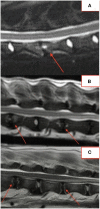Brucella canis discospondylitis in 33 dogs
- PMID: 36406064
- PMCID: PMC9672337
- DOI: 10.3389/fvets.2022.1043610
Brucella canis discospondylitis in 33 dogs
Abstract
Objective: To describe the clinical and imaging findings of 33 dogs with Brucella canis discospondylitis (BDS).
Animals: 33 client owned dogs from four veterinary specialty hospitals within Colorado and Arizona with at least one positive B. canis test and spinal diagnostic imaging.
Procedures: Retrospective review of signalment, physical and neurological examination findings, laboratory results, B. canis serology, and diagnostic imaging of 33 dogs with BDS. All imaging was reviewed by a board-certified veterinary neurologist. Radiographs were reviewed by a board-certified veterinary radiologist blinded to MRI and CT findings.
Results: 31/33 (94%) dogs were <5 years old (median = 2.5 years, mean = 2.9 years, range 0.5-10 years). 21/29 (72%) dogs had signs of nonspecific pain, spinal pain, or lameness for >3 months (median = 6 months, mean = 8.2 months, range 5 days-4 years). Fever was seen in only 4/28 (14%) dogs. Multifocal lesions were evident on radiographs in 21/29 (72%) dogs and MRI in 12/18 (67%) dogs. Smooth, round, central end-plate lysis, defined as "hole punch" lesions, were identified radiographically in 25/29 (86%) dogs. Vertebral physitis or spondylitis without discitis was evident on MRI in 7/18 (39%) dogs.
Clinical relevance: Dogs with BDS typically present at a young age with a long duration of clinical signs. Identification of radiographic "hole punch" lesions and MRI evidence of vertebral physitis, spondylitis, and paravertebral inflammation without discitis should increase suspicion for BDS. BDS may be increasing in frequency in the southwestern United States, and dogs with signs of chronic spinal pain and/or lameness should be screened for B. canis.
Keywords: brucellosis; discitis; infection; osteomyelitis; vertebra.
Copyright © 2022 Long, Burgers, Copple, Stainback, Packer, Kopf, Schmidt, Emch and Windsor.
Conflict of interest statement
The authors declare that the research was conducted in the absence of any commercial or financial relationships that could be construed as a potential conflict of interest.
Figures





Similar articles
-
Clinical Features That Increase Suspicion of Brucella canis Infection in Dogs With Discospondylitis: A Multicenter Case-Control Study.J Vet Intern Med. 2025 May-Jun;39(3):e70112. doi: 10.1111/jvim.70112. J Vet Intern Med. 2025. PMID: 40317976 Free PMC article.
-
Canine brucellosis in three littermates, case report.Front Vet Sci. 2022 Oct 6;9:958390. doi: 10.3389/fvets.2022.958390. eCollection 2022. Front Vet Sci. 2022. PMID: 36277065 Free PMC article.
-
Canine Brucellosis: Insights Into the Epidemiologic Situation in Europe.Front Vet Sci. 2019 May 31;6:151. doi: 10.3389/fvets.2019.00151. eCollection 2019. Front Vet Sci. 2019. PMID: 31214601 Free PMC article.
-
Diagnostic Imaging of Discospondylitis.Vet Clin North Am Small Anim Pract. 2018 Jan;48(1):85-94. doi: 10.1016/j.cvsm.2017.08.007. Epub 2017 Sep 28. Vet Clin North Am Small Anim Pract. 2018. PMID: 28964545 Review.
-
Diskospondylitis and other vertebral infections.Vet Clin North Am Small Anim Pract. 2000 Jan;30(1):169-82, vii. doi: 10.1016/s0195-5616(00)50008-4. Vet Clin North Am Small Anim Pract. 2000. PMID: 10680214 Review.
Cited by
-
Brucella osteoarthritis: recent progress and future directions.Front Microbiol. 2025 Feb 4;16:1522537. doi: 10.3389/fmicb.2025.1522537. eCollection 2025. Front Microbiol. 2025. PMID: 39967734 Free PMC article. Review.
-
Brucellosis in humans caused by Brucella canis: A scoping review.Can Vet J. 2025 Mar;66(3):327-334. Can Vet J. 2025. PMID: 40070936 Free PMC article.
-
Clinical Features That Increase Suspicion of Brucella canis Infection in Dogs With Discospondylitis: A Multicenter Case-Control Study.J Vet Intern Med. 2025 May-Jun;39(3):e70112. doi: 10.1111/jvim.70112. J Vet Intern Med. 2025. PMID: 40317976 Free PMC article.
-
Evaluation of Three Serological Tests for Diagnosis of Canine Brucellosis.Microorganisms. 2023 Aug 26;11(9):2162. doi: 10.3390/microorganisms11092162. Microorganisms. 2023. PMID: 37764006 Free PMC article.
-
Causal Agent Investigation and Treatment of Dogs Diagnosed with Discospondylitis in a Brucella canis Endemic Region.Vet Sci. 2024 Jun 18;11(6):279. doi: 10.3390/vetsci11060279. Vet Sci. 2024. PMID: 38922026 Free PMC article.
References
LinkOut - more resources
Full Text Sources

